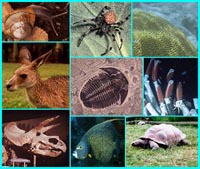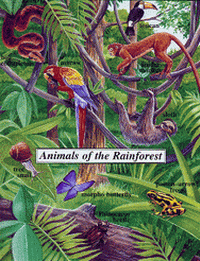Login form
Animals
 Animals
Animals
live everywhere. They roam the land. They burrow in the ground. They swim in the sea. They fly through the air. They creep, they leap, they soar, and they dive. A very few—including corals and barnacles—stay in one place.
Animals come in all sizes. The biggest animals are whales, which can be 100 feet (30 meters) long. The smallest animals can only be seen through a microscope.
Zoologists (scientists who study animals) have found more than 2 million species (kinds) of animals. They think they have discovered only a small portion of all animals on Earth.
Several things make animals different from other living things. Unlike plants, animals cannot make their own food. Animals eat other living things—plants and other animals—to get energy. Animal bodies are made up of more than one cell, unlike bacteria and other life forms with only one cell. Cells are the building blocks of living things. Animals also have senses, such as eyes or ears, that tell them what is going on around them.
Animals live everywhere. They roam the land. They burrow in the ground. They swim in the sea. They fly through the air. They creep, they leap, they soar, and they dive. A very few—including corals and barnacles—stay in one place.
Animals come in all sizes. The biggest animals are whales, which can be 100 feet (30 meters) long. The smallest animals can only be seen through a microscope.
Zoologists (scientists who study animals) have found more than 2 million species (kinds) of animals. They think they have discovered only a small portion of all animals on Earth.
Several things make animals different from other living things. Unlike plants, animals cannot make their own food. Animals eat other living things—plants and other animals—to get energy. Animal bodies are made up of more than one cell, unlike bacteria and other life forms with only one cell. Cells are the building blocks of living things. Animals also have senses, such as eyes or ears, that tell them what is going on around them.
 HOW ANIMALS BREATHE
HOW ANIMALS BREATHE
All animals must breathe oxygen to stay alive. They must breathe out a waste gas called carbon dioxide.
Some animals breathe through lungs. Lungs take oxygen out of air. Cattle, dogs, cats, whales, people, and other mammals breathe through lungs. Birds and reptiles also breathe air through lungs.
Lungs cannot take air from water. Seals, whales, dolphins, and other mammals that live in water breathe through lungs. They can stay underwater a long time because they can hold their breath for a long time.
Sharks and other fish breathe through gills. Gills take oxygen out of water. Snails, slugs, clams, squids, octopuses, and other mollusks breathe through gills. Crabs, crayfishes, lobsters, and shrimp have gills. Gills cannot take oxygen out of air.
Some animals breathe through their skin. Insects have small holes in their bodies called spiracles. Air comes in through the holes. Oxygen from the air goes through tubes to all parts of an insect’s body.
Amphibians, animals that live on land and in water, can also breathe through their skin. Amphibians also may have lungs or gills or both.

